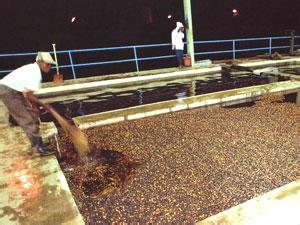Introduction to the treatment of raw coffee beans-washing method
Coffee washing began in the mid-18th century. In the washing process, the pulp of the coffee fruit (red cherry) is first removed, then the residual mucous membrane on the inner pericarp is removed by a fermentation tank, and the beans are washed and dried. The difference between the non-washing method and the water washing method is that the non-washing method is to remove the pulp after drying, while the washing method is to remove the pulp before drying.
The water washing method can remove impurities (stone or garbage, etc.) and defective beans through each step, so the appearance of raw beans is uniform, is generally considered to be of high quality, and the trading price is higher than that of coffee beans refined by natural drying.
However, the more detailed the division of labor, the more procedures for operation and hygiene management, and the higher the risk, so washing is not necessarily equal to high quality. The biggest disadvantage of washed coffee is that coffee beans are prone to the stench of fermentation during fermentation. Some coffee experts point out: "A fermented coffee bean will spoil 50 grams of beans." Beans will be stained with the smell of fermentation, most of which are due to the lack of management and maintenance of the fermentation tank. Soaking the coffee beans with mucous membrane on the endocarp in the fermentation tank for one night can remove the mucous membrane. However, if the microbes in the fermentation tank change, it will cause the coffee beans to be stained with fermented flavor.
In addition, the equipment cost of coffee washing method is high, the washing steps are also quite time-consuming, and the production cost is relatively higher.

Washing steps:
1. Choose beans:
Put the harvested fruit in a water tank and soak for about 24 hours. At this time, ripe fruit will sink, while immature and overripe fruit will float up and can be removed.
two。 Remove the pulp:
Use a machine to remove the peel and pulp, leaving only coffee beans wrapped in endocarp. At this time, there is a layer of mucous membrane on the outside of the beans, and the process of washing is to wash this layer of mucous membrane.
3. Hair alcohol:
The adhesion of the mucous membrane is very strong and is not easy to remove. It must be placed in the slot for about 18-36 hours to make it alcohol and decompose the mucous membrane. There are two methods of fermentation, namely wet hair alcohol and dry hair alcohol, as the name implies, the former adds water, the latter does not add water. In the process of producing alcohol, the seeds and internal pulp will produce special changes, which is one of the steps that most affect the flavor of coffee. Some farms add hot water or alkanolins to speed up the production of alcohol, which has a negative impact on the quality of coffee beans and is not popular with selected coffee lovers.
4. Washing:
Farms that use the washing method must build washing ponds and be able to introduce an endless supply of running water. During the treatment, the finished beans are put into the pool and passed back and forth, using the friction of beans and the power of running water to wash the coffee beans until smooth and clean.
5. Dry:
After washing, at this time, the coffee beans are still wrapped in the pericarp with a moisture content of 50%. They must be dried to reduce the moisture content to 12%, otherwise they will continue to be mellow, moldy and rotten. The better treatment is to use sunlight to dry, although it will take 1-3 weeks, but the flavor is very good and very popular. In addition, machine drying is used in some places, which greatly shortens the processing time and makes the flavor not as good as that of sun-dried coffee.
6. Shelling:
The dried beans can be stored in a warehouse or handed over to the factory for shelling to remove endocarp and silver film.
7. Selection and grading:
Like tanning hair, washed coffee has a process of picking and grading, which is used to remove defective beans and ensure better quality, which is then handed over to exporters to sell around the world.
Important Notice :
前街咖啡 FrontStreet Coffee has moved to new addredd:
FrontStreet Coffee Address: 315,Donghua East Road,GuangZhou
Tel:020 38364473
- Prev

Latte-classic blend of espresso and milk
Latte is the transliteration of Italian Latte. Latte (CoffeeLatte) is a kind of fancy coffee. Latte is a classic blend of Italian espresso and milk. Italians also like lattes as breakfast drinks. In the Italian kitchen in the morning, coffee and milk are usually brewed on the sunlit stove. The Italian who drinks lattes, not so much him.
- Next

Introduction to the treatment of raw coffee beans-tanning method
Sun treatment will first identify sunken beans in the sink, that is, ripe or half-ripe beans are spread in the drying farm for natural drying. The specific time depends on the local climatic conditions, which usually takes two to four weeks. When the moisture of the coffee bean is reduced to 12%, then use a sheller to grind off the hard pulp and silver skin. The requirement of the sun treatment on the climate is very high.
Related
- What is the meaning of lactic acid fermentation with coffee bean treatment?
- How to judge the state of foam by sound?
- How does the latte pull out the unicorn pattern? Come to get for a little trick to improve the flower pull!
- Will flower pulling affect the taste of the latte?
- Do you know the history of coffee?
- The difference between honey treatment and sun washing what is raisin honey treatment?
- What kind of milk can a novice use to make coffee foam to keep the foam longer? The correct method and skills of milking tutorial sharing
- Why do washed coffee beans taste sour? Flavor characteristics of washed Coffee
- Introduction to the skill of how to practice the size and height of water injection around the circle of hand-brewed coffee
- How do beginners practice coffee flower drawing from scratch?

